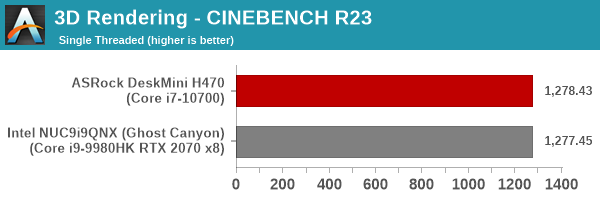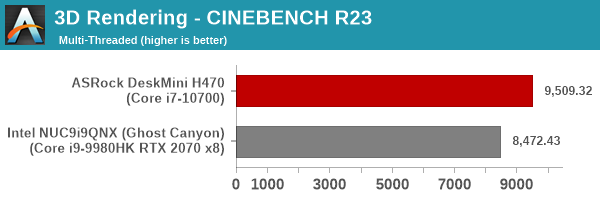ASRock DeskMini H470 Review: A No-Frills LGA 1200 mini-PC Platform
by Ganesh T S on December 29, 2020 8:00 AM ESTMiscellaneous Performance Metrics
This section looks at some of the other commonly used benchmarks representative of the performance of specific real-world applications.
3D Rendering - CINEBENCH
We use CINEBENCH R15 and R23 for 3D rendering evaluation. R15 provides three benchmark modes - OpenGL, single threaded and multi-threaded, while R23 provides only single and multi-threaded modes. Evaluation of different PC configurations in all supported modes provided us the following results.





CINEBENCH R23 seems to be better optimized for the newer Intel processors - In R15, the multi-threaded workload performance put the Core i9-9980HK in a better position than the Core i7-10700. In R23, we see the situation reversed (as it should be, given that the Core i7-10700 has a 20W additional TDP budget to work with). In the R15 OpenGL performance, we see the iGPU-only machines perform worse than the dGPU-equipped ones. In the iGPU category, it is no surprise that the AMD one performs better.
x265 Benchmark
Next up, we have some video encoding benchmarks using x265 v2.8. The appropriate encoder executable is chosen based on the supported CPU features. In the first case, we encode 600 1080p YUV 4:2:0 frames into a 1080p30 HEVC Main-profile compatible video stream at 1 Mbps and record the average number of frames encoded per second.

Our second test case is 1200 4K YUV 4:2:0 frames getting encoded into a 4Kp60 HEVC Main10-profile video stream at 35 Mbps. The encoding FPS is recorded.

The 8C/16T configuration of the Ghost Canyon NUC and the DeskMini H470 helps them get the top two slots, while the other systems are at a core count and clock-speed disadvantage.
7-Zip
7-Zip is a very effective and efficient compression program, often beating out OpenCL accelerated commercial programs in benchmarks even while using just the CPU power. 7-Zip has a benchmarking program that provides tons of details regarding the underlying CPU's efficiency. In this subsection, we are interested in the compression and decompression rates when utilizing all the available threads for the LZMA algorithm.


This is again a benchmark / utility program that loves multiple cores, and the fast 8C/16T configuration again sees the Ghost Canyon NUC and the DeskMini H470 in the top two. Since the benchmark is not a sustained one, the 5GHz turbo helps the Ghost Canyon NUC edge ahead in both components.
Cryptography Benchmarks
Cryptography has become an indispensable part of our interaction with computing systems. Almost all modern systems have some sort of hardware-acceleration for making cryptographic operations faster and more power efficient. In this sub-section, we look at two different real-world applications that may make use of this acceleration.
BitLocker is a Windows features that encrypts entire disk volumes. While drives that offer encryption capabilities are dealt with using that feature, most legacy systems and external drives have to use the host system implementation. Windows has no direct benchmark for BitLocker. However, we cooked up a BitLocker operation sequence to determine the adeptness of the system at handling BitLocker operations. We start off with a 2.5GB RAM drive in which a 2GB VHD (virtual hard disk) is created. This VHD is then mounted, and BitLocker is enabled on the volume. Once the BitLocker encryption process gets done, BitLocker is disabled. This triggers a decryption process. The times taken to complete the encryption and decryption are recorded. This process is repeated 25 times, and the average of the last 20 iterations is graphed below.


The benchmark numbers are affected by multiple aspects - the speeds of the AES-NI engines, core counts, memory speed, and memory latency. The DeskMini H470 comes in the middle of the pack.
Creation of secure archives is best done through the use of AES-256 as the encryption method while password protecting ZIP files. We re-use the benchmark mode of 7-Zip to determine the AES256-CBC encryption and decryption rates using pure software as well as AES-NI. Note that the 7-Zip benchmark uses a 48KB buffer for this purpose.


The 65W TDP budget and the 8C/16T configuration help the Core i7-10700-equipped DeskMini H470 emerge the winner when access to the external DRAM is not a factor (the 48KB buffer easily fits within the processor memory)
Yet another cryptography application is secure network communication. OpenSSL can take advantage of the acceleration provided by the host system to make operations faster. It also has a benchmark mode that can use varying buffer sizes. We recorded the processing rate for a 8KB buffer using the hardware-accelerated AES256-CBC-HAC-SHA1 feature.


AMD's hardware acceleration for OpenSSL enables it to decrypt much faster than the competition and perform admirably for encryption. The Ghost Canyon NUC and DeskMini H470 perform similar to each other, but the DeskMini A300 with the Ryzen 5 2400G walks away with the overall honors.
Agisoft Photoscan
Agisoft PhotoScan is a commercial program that converts 2D images into 3D point maps, meshes and textures. The program designers sent us a command line version in order to evaluate the efficiency of various systems that go under our review scanner. The command line version has two benchmark modes, one using the CPU and the other using both the CPU and GPU (via OpenCL). We present the results from our evaluation using the CPU mode only. The benchmark (v1.3) takes 84 photographs and does four stages of computation:
- Stage 1: Align Photographs (capable of OpenCL acceleration)
- Stage 2: Build Point Cloud (capable of OpenCL acceleration)
- Stage 3: Build Mesh
- Stage 4: Build Textures
We record the time taken for each stage. Since various elements of the software are single threaded, and others multithreaded, it is interesting to record the effects of CPU generations, speeds, number of cores, and DRAM parameters using this software.




This benchmark is one that loves fast high-performance cores capable of sustaining high clock rates. It is no surprise that the 65W 8C/16T configuration helps the DeskMini H470 be in the top three across all stages.
Dolphin Emulator
Wrapping up our application benchmark numbers is the new Dolphin Emulator (v5) benchmark mode results. This is again a test of the CPU capabilities.

The DeskMini H470 performs almost as good as the Ghost Canyon NUC and is at the top of the charts.










26 Comments
View All Comments
jeremyshaw - Tuesday, December 29, 2020 - link
I had the FT03 mini as well. There really isn't much of a way to cool the CPU in that chassis. Same with the GPU. It's a slightly worse SG05 with less venting (I guess a token sliver of vents was added above the IO plate). Why they didn't use the fullsize FT03 layout to preserve some semblance of CPU heatsink clearance? Who knows. Maybe they had the SG05 tooling on hand already.Coming from a FT03 fullsize (which I have a litany of grievances with, even though I liked the case overall), the mini just missed the mark for me.
Samus - Wednesday, December 30, 2020 - link
I agree with your sentiments. And I still question my sanity for living with it but I really do love it. It's beautiful. The key to making it work is obviously using a GPU with a blower, which is now virtually impossible to find as even nVidia has abandoned the Titan-class vapor chamber coolers. Every bit of excess heat needs to be exhausted from this case and a GPU blower actually HELPS cool the rest of the case while gaming.Danvelopment - Friday, January 1, 2021 - link
"14nm (optimized)"[chuckles in an optimised fashion]
Danvelopment - Friday, January 1, 2021 - link
They better be making HUGE dies to still be stringing that one out. Die sizes shrunk dramatically after Intel's last leap with Sandy Bridge because $$$.Quango - Wednesday, January 27, 2021 - link
Asrock has released a BIOS 2.0 for the Deskmini H470 with "Support 11th Gen processors".The second M.2 slot on the backside now appears in the BIOS settings and in HWInfo, but I don't know yet if it is functional with Comet Lake.
flee2021 - Thursday, February 4, 2021 - link
Intel 400 series chipset M.2 slots connect to the PCH and not the CPU. So the second M.2 slot should work without problems. I am looking forward to seeing what the Intel 11th Gen Core processors' CPU PCIe 4.0 x4 slots can do for the M.2 slot when the 500 series motherboards are available.